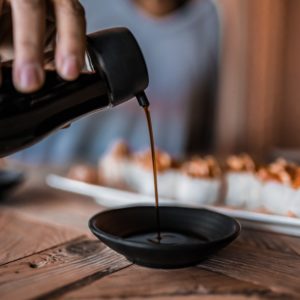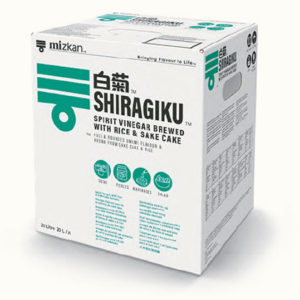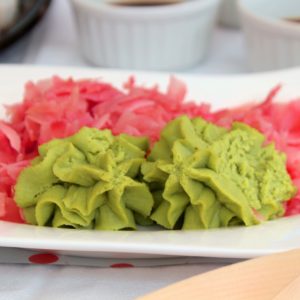12th August, 2021
Are you a chef looking to get into Japanese cuisine or just want to explore different flavours and mix them within your European, Latin American, Pan-Asian or even Middle Eastern cuisine?
Getting into a new cuisine and sourcing the ingredients required to make a new dish can be challenging if you aren’t familiar with the ingredients. This guide will walk you through some essential Japanese ingredients every chef must have in their kitchen.
Just like any world cuisine, Japanese cuisine has a group of core ingredients that are used in nearly all dishes.
These ingredients can not only be used together to create a variety of delicious Japanese dishes and used on their own as sauces and toppings – but they can also be mixed with other world-famous ingredients to create fusion recipes.
So, let’s find out all the must-have Japanese ingredients every fusion chef needs in their kitchen.
Soy Sauce

Let’s start off with a simple yet basic ingredient that isn’t only popular in Japanese cuisine, but it’s also widely used to complement western dishes such as braised beef with mixed vegetables or the popular tomato and basil pasta sauce.
Soy sauce is Japanese cuisine’s most basic flavour that goes well with almost everything. It’s not only used as a base ingredient in broths and soups, but it’s also widely used as a sauce for dips, dressings and marinades.
The ingredient is made of boiled soybeans, wheat, salt, and water. The soybeans and wheat are fermented together for a couple of days and then water and salt are added in and left for long periods of time. This traditional fermenting process takes months and often years.
Not all Japanese soy sauces are the same. Different amounts of salt, soybeans, wheat, and brewing time can impact the final flavour. However, there are two main types of soy sauces:
Rice Vinegar
Rice vinegar can be used for seasoning rice, for pickling, in marinades, sauces, salad dressings and even in cocktails. The product is generally less acidic than many western vinegars such as the balsamic and red wine vinegars.
The ingredient is made by fermenting boiled koji rice starches using yeast. The yeast then converts the sugar from the rice into alcohol and eventually becomes rice vinegar after acetic acid fermentation. High quality rice vinegars usually take weeks and even months to make as they are fermented traditionally to create a distinct flavour.
Mizkan’s rice vinegar Yumai is light in colour, has a clear aroma as it is only made from rice, rich flavour and mellow acidity – an essential in all Japanese kitchens. The ingredient does not only complement sushi dishes, but it can complement a variety of warm and cold dishes such as stir-fries soups and broths, salad dressings, sauces and desserts.
Spirit Vinegar

If you’re looking for a spirit vinegar that has a profound umami and rice flavour, then Mizkan’s Shiragiku is exactly what you’re looking for.
The Shiragiku brewing process consists of sake lees being matured until they get a brownish shade. Rice extract, fresh sake lees and matured sake lees is then cooked together followed by enzyme fermentation which results in the final product.
Usually slightly darker than standard spirit vinegar, Shiragiku has a rich, umami-like taste which makes it popular in high-end sushi restaurants.
The ingredient goes extremely well with pickling, marinades, stir-fries, salad dressings and even cocktails. Check out a variety of our recipes such as black belly pork or our scallops with asparagus, rhubarb and pickles to find out exactly how the ingredient is used in different dishes.
Mirin
You may have noticed that many Japanese dishes have an umami taste, sweetness and a subtle tang which is often hard to place – the secret behind this complex flavour is Mirin.
One of the most enchanting ingredients of Japanese seasoning elements, Mirin is often used as a sugar replacement to add a complex sweetness to any dish.
Just like sake, mirin is an alcoholic ingredient (contains 12% alcohol) made from koji rice fermented for few months up to several years. What differentiates the two is mirin having a sweeter taste and lower alcohol levels compared to sake.
However, if you’re looking for a mirin-style ingredient that has even lower levels of alcohol than mirin, our Mizkan Honteri Mirin style is the perfect substitute. The seasoning has the same flavour profile but with almost no alcohol – only 0.5%, which is equivalent to the percentage of alcohol in a ripe banana.
Honteri consists of spirit vinegar and sweet rice wine. It adds a complex roundness to a variety of cuisines, but with the convenience of not having to be boiled to evaporate the alcohol. It works well with both savoury and sweet dishes like our salmon tartare bites or the fluffy Japanese pancakes.
Miso
Miso consists of a thick paste with a soft spreadable consistency made from fermented soybeans and koji.
For a very long time, this ingredient was unknown outside of Japan, but with an increasing interest in Japanese cuisine it’s now widely known and used in the west.
Apart from miso soup, the paste is used in many dishes. However, that depends on the type of miso paste as different variations pair well with different foods. There are two main types:
Sushi Rice
Sushi rice also known as Japanese rice is the most important Japanese ingredient as it is used in many dishes such as sushi, onigiri and curry. Unlike Indian and Chinese rice, Japanese rice has short pebble-shaped grains that when cooked release starch that sticks the rice together.
That is why this type of rice is perfect for sushi as it clumps together which makes it easier to eat with chopsticks. Learn how to make sushi rice through our step-by-step video guide.
Apart from being used with sushi, Japanese rice is served alongside a variety of other dishes such as curries and pokes.
Noodles
Another widely consumed ingredient in Japanese cuisine are noodles. They come in many different types depending on the variety of dishes they are used in.
For example, they are used in soups to make dishes such as the Ramen Tonkotsu Soup or in stir-fried dishes such as Maze Tantan Men. However, the three most popular noodle types are:
Wasabi

Real wasabi is made of wasabi root which is very expensive as it’s extremely difficult to farm correctly. The majority of wasabi paste we see in supermarkets is made of horseradish, which is closely related to the wasabi root.
This green paste that we often find with sushi is made by grating the horseradish root and mixing oil, water, and green coloured dye. Like all the ingredients mentioned in this blog, wasabi is also widely used within Japanese dishes, from being paired with boiled eggs to being used with chicken or seafood.
Finally, these ingredients are the foundation of Japanese cuisine and without any one of these, there would be no authentic Japanese dish.
Any chef, specifically those involved in European cuisine, can use these ingredients to create exciting fusion recipes.
To find out where you’ll be able to get products with a rich umami taste like vinegars containing sake lees or sweeter, more complex flavours such as Honteri Mirin style seasoning – get in touch with us today and you’ll soon be ready to cook a variety of delicious dishes.

